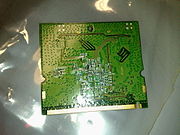RouterOS[edit]
The main product of MikroTik is an operating system based on the Linux kernel, known as the MikroTik RouterOS. Installed on the company's proprietary hardware (RouterBOARD series), or on standard x86-based computers, it turns a computer into a network routerand implements various additional features, such as firewalling, virtual private network (VPN) service and client,[4] bandwidth shaping and quality of service, wireless access point functions and other commonly used features when interconnecting networks. The system is also able to serve as a captive-portal-based hotspot system.
The operating system is licensed in increasing service levels, each releasing more of the available RouterOS features. A MS Windows application called Winbox provides a graphical user interface for the RouterOS configuration and monitoring, but RouterOS also allows access via FTP, telnet, and secure shell (SSH). An application programming interface is available for direct access from applications for management and monitoring.
Features[edit]
RouterOS supports many applications used by Internet service providers, for example OSPF, BGP, Multiprotocol Label Switching(VPLS/MPLS), OpenFlow. The product is supported by Mikrotik through a forum and a wiki, providing assorted and thematic examples of configurations. RouterOS supports Internet Protocol Version 4 (IPv4) as well as Internet Protocol Version 6 (IPv6).
The software provides support for virtually all network interfaces that the Linux kernel 3.3.5 supports, except wireless, where the Atheroschipsets are the only supported hardware, as of RouterOS version 6.33.
Release history[edit]
- RouterOS version 6: May 2013[5]
- RouterOS version 6.38 (December 30, 2016)
- RouterOS version 5: March 2010
- RouterOS version 4: October 2009
- RouterOS version 3: January 2008
RouterBOARD[edit]
The company manufactures a series of integrated circuit boards, marketed under the name RouterBOARD, as well as accessory components which implement a complete hardware operating platform for RouterOS.
The RouterBOARD line, combined with RouterOS, is marketed at small- to medium-sized wireless Internet service providers, typically providing broadband wireless access in remote areas. Products include pre-assembled small office/home office (SOHO) routers, wireless 802.11a/b/g/n/ac MIMO and TDMA devices for indoor and outdoor use, and also bare routers in form of printed circuit boards (PCBs) for integration into custom solutions. Also, the RouterBOARD line includes a series of Mini PCIand Mini PCI Express wireless adapters, supporting a range of IEEE 802.11 protocols, and designed to be used together with the router boards lineup.
Some RouterBOARD boards and their versions are supported by third-party Linux-based firmware, notably OpenWrt.[6][7][8][9][10]
Cloud Core Router[edit]
In November 2012, MikroTik released the Cloud Core Router integrated unit which is based on the Tilera CPU supporting nine to 72 CPU cores, 8 SFP+ (MiniGBIC) interfaces, as well as "fast-path" packet forwarding between interfaces (with independently tested 119 million packets and 80 Gbit/s forwarding rate[15]). This unit targets the medium-sized network providers as well as try to be a well priced alternative to the other more well-known brands.
MikroTik User Meeting (MUM)[edit]
The MUM is a conference and exhibition about networking, more targeted at MikroTik device users. Started as a regular gathering of forum users in January 2006, the events are now taking place every few weeks around the world, gathering hundreds of people at every event. The biggest event As of November 2015 was in Yogyakarta, Indonesia, gathering 2650 people.[16]
Use in developing IT markets[edit]
In 2004, a project began to build low-cost Internet infrastructure in rural Mali. MikroTik routers and their operating system were chosen because of their low cost, flexibility, the fact that the system already had "a substantial user base in Mali", and had a user interface deemed "superior to other products".[17] MikroTik routers were also preferred for a WLAN project in Burkina Faso,[18] and MikroTik's proprietary Nstreme protocol performed better than IEEE 802.11 under the project's conditions.[19]
In 2008, the Municipality of Piripiri, Piauí State, Brazil, decided to use MikroTik routers exclusively to build the infrastructure for providing free Internet access.[20] MikroTik routers are also popular in the Czech Republic and Hungary, where they enjoy a good reputation.[21]
Under OLPC program, Uruguay deployed a nationwide wireless network in schools. Probably the largest Mikrotik deployment in a country with a total population of 3 million.[citation needed] Approximately 200,000 students received a small laptop which connected to Mikrotik access points.
Vulnerabilities[edit]
On June 15, 2015, Brian Krebs, an online reporter, reported that "recently, researchers at the Fujitsu Security Operations Center in Warrington, UK began tracking [the] Upatre [trojan software] being served from hundreds of compromised home routers – particularly routers powered by MikroTik and Ubiquiti’s AirOS." A vulnerability hasn't been linked with this incident and Bryan Campbell, the lead threat intelligence analyst at Fujitsu says while a vulnerability could exist, this could also be the result of unsecured devices that still have default credentials enabled.[22][additional citation needed]








Tidak ada komentar:
Posting Komentar